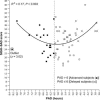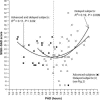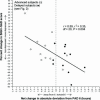The circadian basis of winter depression
- PMID: 16648247
- PMCID: PMC1450113
- DOI: 10.1073/pnas.0602425103
The circadian basis of winter depression
Abstract
The following test of the circadian phase-shift hypothesis for patients with winter depression (seasonal affective disorder, or SAD) uses low-dose melatonin administration in the morning or afternoon/evening to induce phase delays or phase advances, respectively, without causing sleepiness. Correlations between depression ratings and circadian phase revealed a therapeutic window for optimal alignment of circadian rhythms that also appears to be useful for phase-typing SAD patients for the purpose of administering treatment at the correct time. These analyses also provide estimates of the circadian component of SAD that may apply to the antidepressant mechanism of action of appropriately timed bright light exposure, the treatment of choice. SAD may be the first psychiatric disorder in which a physiological marker correlates with symptom severity before, and in the course of, treatment in the same patients. The findings support the phase-shift hypothesis for SAD, as well as suggest a way to assess the circadian component of other psychiatric, sleep, and chronobiologic disorders.
Conflict of interest statement
Conflict of interest statement: A.J.L. is coinventor on several melatonin use-patents owned by Oregon Health & Science University currently not licensed to any company.
Figures






References
-
- Lewy A. J., Bauer V. K., Ahmed S., Thomas K. H., Cutler N. L., Singer C. M., Moffit M. T., Sack R. L. Chronobiol. Int. 1998;15:71–83. - PubMed
-
- Sack R. L., Brandes R. W., Kendall A. R., Lewy A. J. N. Engl. J. Med. 2000;343:1070–1077. - PubMed
-
- Hack L. M., Lockley S. W., Arendt J., Skene D. J. J. Biol. Rhythms. 2003;18:420–429. - PubMed
-
- Bunney B. G., Potkin S. G., Bunney W. E. In: Biology of Depression: From Novel Insights to Therapeutic Strategies. Licinio J., Wong M. L., editors. Vol. 1. Hoboken, NJ: Wiley; 2005. pp. 467–483.
-
- Rosenthal N. E. Winter Blues. New York: Guilford; 1998.
Publication types
MeSH terms
Substances
Grants and funding
LinkOut - more resources
Full Text Sources
Other Literature Sources
Medical

